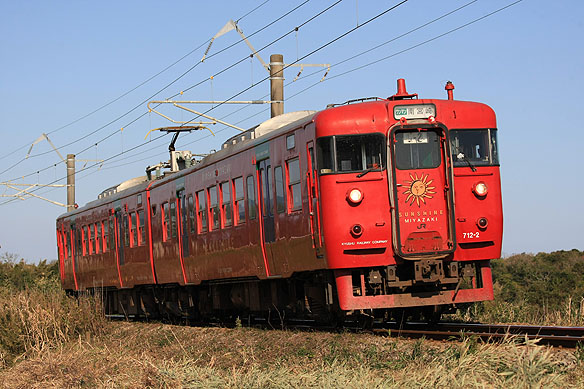Background and overview
Japanese National Railways (JNR) developed 713-900 series suburban AC electric
multiple unit (EMU) trains in order to replace trains powered by locomotives,
and delivered 4 pre-production sets in 1983. 713 series are 2 car formation
consisting of a powered end car, Kumoha713, and a trailer end car, Kuha712.
3 car formation is available to insert an intermediate trailer vehicle
in the future.
Car body
JNR had a plan to introduce a light-weight stainless body to 713 series.
But finally, JNR adopted a body constructed by steel for cost reduction.
They are equipped with 2 double-leaf automatic sliding doors on each side
of the vehicles. They are also equipped with double-hung unit assembled
windows and door case windows between the doors, incorporating a step at
the doorway. Roller-binding destination screens are fitted on the body.
Their livery was white with the single green waistline band running the
length of each car below the windows. An air conditioner, AU710 rated at
38,000kcal/h, is fitted on the centre of their roof. Forced ventilators
are fitted on the both side of the air conditioner. Their air conditioner
is powered from the third wiring of the transformer.
Bogies
713 series featured DT21/TR62 coil suspension bogies for cost reduction.
Motored bogies, DT21D, differ from existing DT21 from employing single
tread brake device.
Traction unit and ancillary equipments
Four powerful shunt-wound brushed DC traction motors, MT61, with a power
output of 150kW and featuring high terminal voltage at 500V, are controlled
by the traction control system, CS55, featuring thyristor phase control
and holding brake. Their field weakening ratio is available to 70%. The
gear ratio is 6.07, so maximum services speed is limited up to 100km/h.
713 series adopt electromagnetic straight pneumatic brake with regenerative
brake. Class Kumoha713 vehicles are equipped with a diamond-shaped current
collector, PS101D. Class Kuha712 vehicles are equipped with a motor driven
air compressor, MH1084-C2000, under the floor.
Accommodation
Seating is arranged as mixture of longitudinal bench seating and transverse seating bays with 1490mm seating pitch. Trailer end cars, Kuha712, have a Japanese style toilet.
Modification and History of Operations
713 series entered the rural services of Nagasaki and Sasebo lines in 1984.
After the splitting of the former JNR into the new privatized JR companies
in April 1987, JR Kyushu received 713 series vehicles and began to change
their livery into white with the single blue waistline band running the
length of each car below the windows.
All 713-900 series vehicles were relocated to Kagoshima depot for the start
of Miyazaki Kuko line in 1996, and underwent extensive refurbishment for
the use on the shuttle services. Externally, sets received a new bright
red "Sunshine" livery with blue colored doors. Internally, the
fixed transverse seating bays were replaced with pairs of new reclining
seating which could be rotated to face the direction of travel and a baggage
rack was fitted next to the doorway. Longitudinal bench seating employs
headrests.
They underwent a second life-extension refurbishment programme, primarily
designed to standardize the traction system built by different manufacturers,
and introducing a new single-arm current collector. So, they were classified
-0 subseries in 2008.
Latest operation status
713 series are now used on the rural services of Nippo and Miyazaki Kuko
lines. |
|



